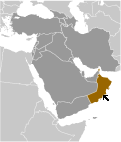World Atlas: Oman. On this page you can see the map, country flag and many detailed information about the people, history and economy of Oman.

Here you can find online selected information about the geography, inhabitants, government, economy and history of Oman. Included are selected statistics, an overview map and the detailed map of Oman. But let's start with the flag of Oman here:
Oman - Overview:
What you should know about Oman? Let's start with this: The inhabitants of the area of Oman have long prospered from Indian Ocean trade. In the late 18th century, the nascent sultanate in Muscat signed the first in a series of friendship treaties with Britain. Over time, Oman's dependence on British political and military advisors increased, although the Sultanate never became a British colony. In 1970, Qaboos bin Said Al-Said overthrew his father, and has since ruled as sultan, but he has not designated a successor. His extensive modernization program has opened the country to the outside world, while preserving the longstanding close ties with the UK and US. Oman's moderate, independent foreign policy has sought to maintain good relations with its neighbors and to avoid external entanglements. Inspired by the popular uprisings that swept the Middle East and North Africa beginning in January 2011, some Omanis staged demonstrations, calling for more jobs and economic benefits and an end to corruption. In response to those protester demands, Qaboos in 2011 pledged to implement economic and political reforms, such as granting legislative and regulatory powers to the Majlis al-Shura and increasing unemployment benefits. Additionally, in August 2012, the Sultan announced a royal directive mandating the speedy implementation of a national job creation plan for thousands of public and private sector Omani jobs. As part of the government's efforts to decentralize authority and allow greater citizen participation in local governance, Oman successfully conducted its first municipal council elections in December 2012. Announced by the Sultan in 2011, the municipal councils have the power to advise the Royal Court on the needs of local districts across Oman's 11 governorates. The Sultan returned to Oman in March 2015 after eight months in Germany, where he received medical treatment. He has since appeared publicly on a few occasions.
Geography of Oman
 Where on the globe is Oman? The location of this country is Middle East, bordering the Arabian Sea, Gulf of Oman, and Persian Gulf, between Yemen and the UAE. Total area of Oman is 309,500 sq km, of which 309,500 sq km is land. So this is quite a large country. How could we describe the terrain of the country? This way: central desert plain, rugged mountains in north and south. The lowest point of Oman is Arabian Sea 0 m, the highest point Jabal Shams 3,004 m. And the climate is dry desert; hot, humid along coast; hot, dry interior; strong southwest summer monsoon (May to September) in far south.
Where on the globe is Oman? The location of this country is Middle East, bordering the Arabian Sea, Gulf of Oman, and Persian Gulf, between Yemen and the UAE. Total area of Oman is 309,500 sq km, of which 309,500 sq km is land. So this is quite a large country. How could we describe the terrain of the country? This way: central desert plain, rugged mountains in north and south. The lowest point of Oman is Arabian Sea 0 m, the highest point Jabal Shams 3,004 m. And the climate is dry desert; hot, humid along coast; hot, dry interior; strong southwest summer monsoon (May to September) in far south.
Inhabitants of Oman
Let's take a look how many people live in Oman. The number is: 3,424,386 (July 2017 est.). So this is not very populous country. Who lives here? Arab, Baluchi, South Asian (Indian, Pakistani, Sri Lankan, Bangladeshi), African. What are the languages in Oman? Arabic (official), English, Baluchi, Urdu, Indian dialects. And the religions: Muslim 85.9%, Christian 6.5%, Hindu 5.5%, Buddhist 0.8%, Jewish . How old are the people in average? 25.6 years. We have to add that this number is the median - so one half of the people is older than this, one half is younger. And what is their life expectancy (at birth)? This: 75.7 years. Where the people live in Oman? Here: the vast majority of the population is located in and around the Al Hagar Mountains in the north of the country; another smaller cluster is found around the city of Salalah in the far south; most of the country remains sparsely poplulated. The major urban areas of Oman are: Muscat (capital) 838,000 (2015).
Government and Economy of Oman
The capital of Oman is Muscat and the government type absolute monarchy. Let's take a look at the administrative divisions - 11 governorates (muhafazat, singular - muhafaza); Ad Dakhiliyah, Al Buraymi, Al Wusta, Az Zahirah, Janub al Batinah (Al Batinah South), Janub ash Sharqiyah (Ash Sharqiyah South), Masqat (Muscat), Musandam, Shamal al Batinah (Al Batinah North), Shamal ash Sharqiyah (Ash Sharqiyah North), Zufar (Dhofar). Regarding the economy of Oman, important industrial products are crude oil production and refining, natural and liquefied natural gas production; construction, cement, copper, steel, chemicals, optic fibe. Important agricultural products are dates, limes, bananas, alfalfa, vegetables; camels, cattle; fish. The most important export commodities are petroleum, reexports, fish, metals, textiles and the most important export partners are China 47.8%, UAE 8.3%, India 4.1% (2016). The most important import commodities are machinery and transport equipment, manufactured goods, food, livestock, lubricants and the most important import partners are UAE 44.9%, China 4.8%, India 4.8% (2016). How rich is Oman and how rich are people in this country? The most important number here is GDP per capita (PPP): $45,500 (2017 est.). This means the people are rich on average here. Let's add that this means Gross Domestic Product per person, which is recalculated with respect to the relative cost of local goods and services. And one more important number - population below poverty line: NA%.